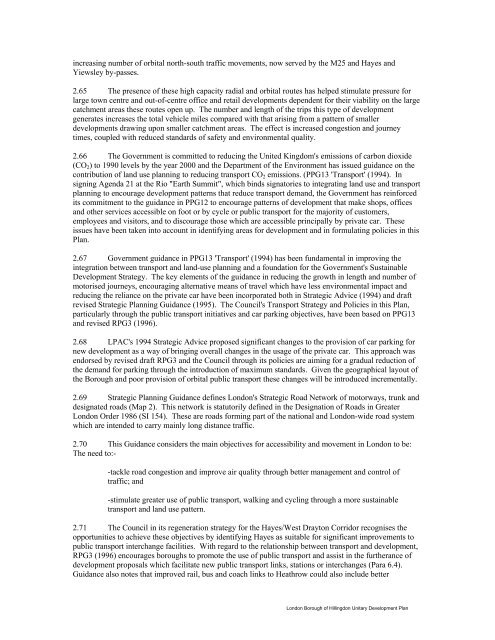HILLINGDON UNITARY DEVELOPMENT PLAN - London Borough ...
HILLINGDON UNITARY DEVELOPMENT PLAN - London Borough ...
HILLINGDON UNITARY DEVELOPMENT PLAN - London Borough ...
Create successful ePaper yourself
Turn your PDF publications into a flip-book with our unique Google optimized e-Paper software.
increasing number of orbital north-south traffic movements, now served by the M25 and Hayes and<br />
Yiewsley by-passes.<br />
2.65 The presence of these high capacity radial and orbital routes has helped stimulate pressure for<br />
large town centre and out-of-centre office and retail developments dependent for their viability on the large<br />
catchment areas these routes open up. The number and length of the trips this type of development<br />
generates increases the total vehicle miles compared with that arising from a pattern of smaller<br />
developments drawing upon smaller catchment areas. The effect is increased congestion and journey<br />
times, coupled with reduced standards of safety and environmental quality.<br />
2.66 The Government is committed to reducing the United Kingdom's emissions of carbon dioxide<br />
(CO 2 ) to 1990 levels by the year 2000 and the Department of the Environment has issued guidance on the<br />
contribution of land use planning to reducing transport CO 2 emissions. (PPG13 'Transport' (1994). In<br />
signing Agenda 21 at the Rio "Earth Summit", which binds signatories to integrating land use and transport<br />
planning to encourage development patterns that reduce transport demand, the Government has reinforced<br />
its commitment to the guidance in PPG12 to encourage patterns of development that make shops, offices<br />
and other services accessible on foot or by cycle or public transport for the majority of customers,<br />
employees and visitors, and to discourage those which are accessible principally by private car. These<br />
issues have been taken into account in identifying areas for development and in formulating policies in this<br />
Plan.<br />
2.67 Government guidance in PPG13 'Transport' (1994) has been fundamental in improving the<br />
integration between transport and land-use planning and a foundation for the Government's Sustainable<br />
Development Strategy. The key elements of the guidance in reducing the growth in length and number of<br />
motorised journeys, encouraging alternative means of travel which have less environmental impact and<br />
reducing the reliance on the private car have been incorporated both in Strategic Advice (1994) and draft<br />
revised Strategic Planning Guidance (1995). The Council's Transport Strategy and Policies in this Plan,<br />
particularly through the public transport initiatives and car parking objectives, have been based on PPG13<br />
and revised RPG3 (1996).<br />
2.68 LPAC's 1994 Strategic Advice proposed significant changes to the provision of car parking for<br />
new development as a way of bringing overall changes in the usage of the private car. This approach was<br />
endorsed by revised draft RPG3 and the Council through its policies are aiming for a gradual reduction of<br />
the demand for parking through the introduction of maximum standards. Given the geographical layout of<br />
the <strong>Borough</strong> and poor provision of orbital public transport these changes will be introduced incrementally.<br />
2.69 Strategic Planning Guidance defines <strong>London</strong>'s Strategic Road Network of motorways, trunk and<br />
designated roads (Map 2). This network is statutorily defined in the Designation of Roads in Greater<br />
<strong>London</strong> Order 1986 (SI 154). These are roads forming part of the national and <strong>London</strong>-wide road system<br />
which are intended to carry mainly long distance traffic.<br />
2.70 This Guidance considers the main objectives for accessibility and movement in <strong>London</strong> to be:<br />
The need to:-<br />
-tackle road congestion and improve air quality through better management and control of<br />
traffic; and<br />
-stimulate greater use of public transport, walking and cycling through a more sustainable<br />
transport and land use pattern.<br />
2.71 The Council in its regeneration strategy for the Hayes/West Drayton Corridor recognises the<br />
opportunities to achieve these objectives by identifying Hayes as suitable for significant improvements to<br />
public transport interchange facilities. With regard to the relationship between transport and development,<br />
RPG3 (1996) encourages boroughs to promote the use of public transport and assist in the furtherance of<br />
development proposals which facilitate new public transport links, stations or interchanges (Para 6.4).<br />
Guidance also notes that improved rail, bus and coach links to Heathrow could also include better<br />
<strong>London</strong> <strong>Borough</strong> of Hillingdon Unitary Development Plan
















